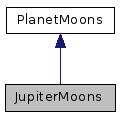kstars
#include <jupitermoons.h>

Public Member Functions | |
| JupiterMoons () | |
| virtual | ~JupiterMoons () |
| virtual void | findPosition (const KSNumbers *num, const KSPlanetBase *jup, const KSSun *sunptr) |
 Public Member Functions inherited from PlanetMoons Public Member Functions inherited from PlanetMoons | |
| PlanetMoons () | |
| virtual | ~PlanetMoons () |
| void | EquatorialToHorizontal (const dms *LSTh, const dms *lat) |
| bool | inFront (int id) const |
| TrailObject * | moon (int id) |
| QString | name (int id) const |
| int | nMoons () const |
| double | x (int i) const |
| double | y (int i) const |
| double | z (int i) const |
Additional Inherited Members | |
 Protected Attributes inherited from PlanetMoons Protected Attributes inherited from PlanetMoons | |
| QVector< bool > | InFront |
| QVector< TrailObject * > | Moon |
| QVector< double > | XP |
| QVector< double > | YP |
| QVector< double > | ZP |
Detailed Description
Implements the four largest moons of Jupiter.
See Chapter 43 of "Astronomical Algorithms"by Jean Meeus for details
TODO: make the moons SkyObjects, rather than just points.
- Version
- 1.0
Definition at line 41 of file jupitermoons.h.
Constructor & Destructor Documentation
| JupiterMoons::JupiterMoons | ( | ) |
Constructor.
Assign the name of each moon, and initialize their XYZ positions to zero.
Definition at line 25 of file jupitermoons.cpp.
|
virtual |
Member Function Documentation
|
virtual |
Find the positions of each Moon, relative to Jupiter.
We use an XYZ coordinate system, centered on Jupiter, where the X-axis corresponds to Jupiter's Equator, the Y-Axis is parallel to Jupiter's Poles, and the Z-axis points along the line joining the Earth and Jupiter. Once the XYZ positions are known, this function also computes the RA,Dec positions of each Moon, and sets the inFront bool variable to indicate whether the Moon is nearer to us than Jupiter or not (this information is used to determine whether the Moon should be drawn on top of Jupiter, or vice versa).
See "Astronomical Algorithms" bu Jean Meeus, Chapter 43.
- Parameters
-
num pointer to the KSNumbers object describing the date/time at which to find the positions. jup pointer to the jupiter object sunptr pointer to the Sun object
Implements PlanetMoons.
Definition at line 42 of file jupitermoons.cpp.
The documentation for this class was generated from the following files:
Documentation copyright © 1996-2014 The KDE developers.
Generated on Tue Oct 14 2014 22:36:22 by doxygen 1.8.7 written by Dimitri van Heesch, © 1997-2006
KDE's Doxygen guidelines are available online.
 KDE API Reference
KDE API Reference